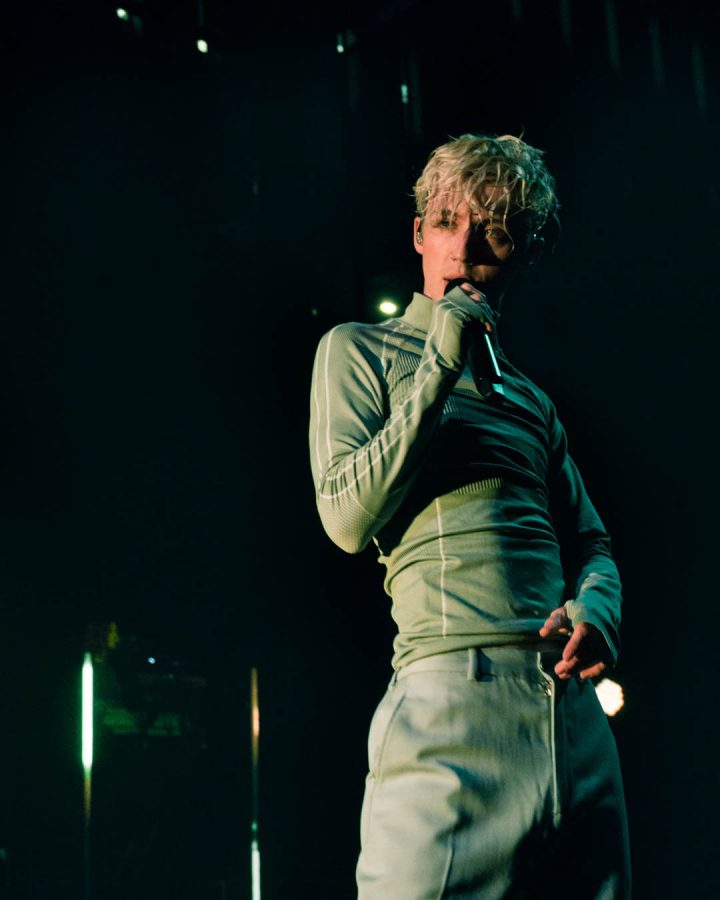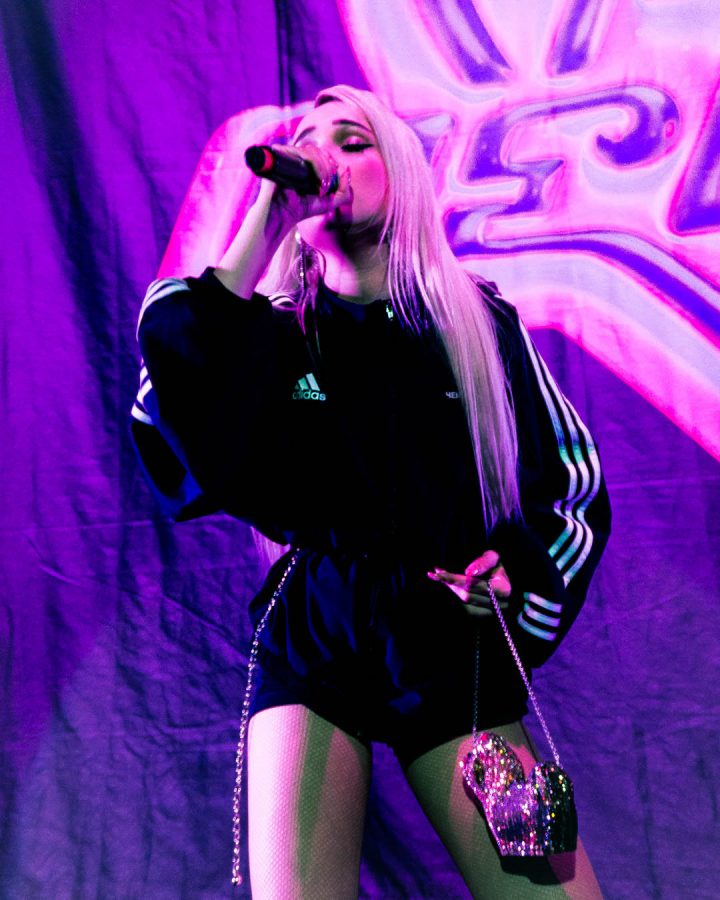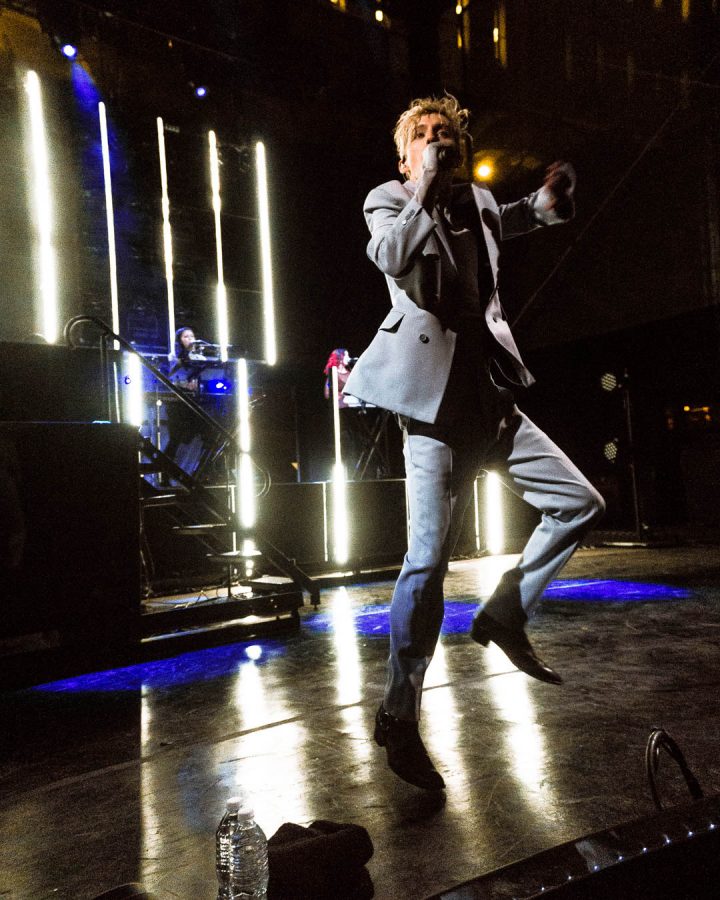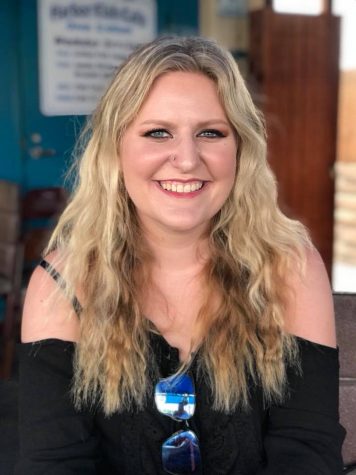Australian pop artist and 2018 critical breakthrough Troye Sivan brought his intimate, inclusive “Bloom” tour to San Diego State’s CalCoast Credit Union Open Air Theatre Oct. 25 with openers Carlie Hanson and Kim Petras, and with them came a culmination of 21st century pop influences.
Hanson, 18, was the first opener, and she brought charisma along with a setlist evocative of 2010s pop to the Open Air Theatre. In an interview with Paper Magazine, she cited Justin Bieber as one of her biggest influences, and that she was discovered by record producers when she posted a cover of Zayn’s “Pillowtalk” online.
A highlight of the rising singer-songwriter’s set was her most recent release, “Toxins,” a post-EDM jam that seemingly builds to a big chorus, only to have the production minimize to just Hanson’s soft vocal delivery over a single guitar. The post-chorus drop, reminiscent of Bieber’s monolith 2015 album, “Purpose,” got the crowd moving — she even had fans of her own in the audience singing along.
Fellow pop vocalist on the rise, Petras, following Hanson, ignited the crowd with a refreshing respect for turn-of-the-century pop. She opened her set with recent single “All the Time,” the kind of bouncy, shoutalong pop song characteristic of “Teenage Dream”-era Katy Perry.
Her breakout single, “I Don’t Want It at All,” followed, and the audience was extremely receptive to the song’s reclaiming of lazily written mean girl stereotypes evident in early 2000s characters like Elle Woods of “Legally Blonde” and Regina George of “Mean Girls.”
“Baby, don’t you fight it,” Petras sang. “Close your eyes and swipe it / Maybe I could be with you.”
Even the video for “I Don’t Want It at All” features ultimate millennial material girl Paris Hilton, emblematic of the kind of 2000s nostalgia evident in Petras’s music and growing widespread as young millennials and Generation Z come of age.
Her set also featured 2018 single “Heart to Break,” one of the best tracks in her catalog and of the year so far. It’s a soaring, melodramatic pop song that begs to be screamed along to during a car ride.
“Even if it means that I’ll never put myself back together / Gonna give you my heart to break,” she belted, one of the several times during her set she got to show off her range.
Main act Sivan came up next. He released his sophomore effort “Bloom” in August, reaching a wider audience than he did on 2015 debut “Blue Neighborhood,” reaching no. 4 on the Billboard 200 album chart and out-peaking his first record by three spots.
Sivan offers warm vulnerability in his music — his recurring themes include instances of love and heartbreak described in vivid detail, and coming to terms with his sexuality.
What’s striking about “Bloom,” though, is its musical backdrop recalling the past decade of pop. Initially gaining a following on YouTube, Sivan, 23, grew up watching the rise of DIY, minimalist dream pop and bedroom pop that thrived online.
Specifically, Sivan’s sound proves the longevity of perhaps the most influential pop album of the 2010s — Lorde’s “Pure Heroine.” Joining the ranks of post-Lorde pop artists like Halsey, Dua Lipa, Alessia Cara and countless others pushed on Spotify’s curated pop playlists, Sivan takes on those pulsating synths and indie, self-made aesthetic to go with his personal storytelling.
He opened with “Bloom’s” opening track, “Seventeen,” which he told The New York Times is inspired by sexual experiences he had with older men via Grindr when he was underage. It’s a rolling, ethereal, coming-of-age song derivative of “Pure Heroine” cut “Ribs,” a favorite among Lorde fans.
“And he said age is just a number, just like any other,” he sang. “We can do whatever, do whatever you want.”
Sivan extended the vulnerability he offers in his lyrics to the banter he shared with the audience during the show. Before performing “Blue Neighborhood” track “Heaven,” he described how the song reflects his preteen years, when he realized he was gay.
“Am I actually going to hell?” he recalled the questions he asked himself when he was younger and grappling with his sexuality. “Will I be able to have kids?”
It was clear his fans, many of whom brought Pride flags and adorned their outfits with rainbow shades, find his same-sex love songs important and resonant.
While a song like “Bloom’s” title track fared better live than on record, the set erred on sleepy in the middle with a string of forgettable “Bloom” ballads: “Postcard,” “The Good Side” and “What a Heavenly Way to Die.”
“1999,” a recent Charli XCX single featuring Sivan, which taps into his affinity for pop nostalgia, brought life back to the stage, before he ended the main set with “Bloom” closer “Animal.”
Fans were eagerly awaiting this track. Prior to the show, several young women were passing out strips of rainbow-colored paper, informing concert-goers to place the paper over their cell phone flashlights during “Animal,” so the crowd would illuminate like a giant Pride flag.
One of Sivan’s most ambitious tracks, “Animal” contains a distorted middle eight influenced by another 2010s pop vanguard: Frank Ocean.
“All is right in the meadow,” he sang during that bridge section. “When I’m lying next to my fellow / Baby, that’s you.”
He encored with “Blue Neighborhood” track “Youth,” a John Hughes anthem for the 2010s, and ended the night with “Bloom” lead single “My My My!”
The latter took an odd turn halfway through the song, morphing into a more uptempo, electronic remix that sounded about five years dated, but still reflected the expanse of 21st century pop Sivan picks and chooses from. And with decades of potential inspirations now archived on streaming services, those reference points in his artistry are certain to continue growing.











